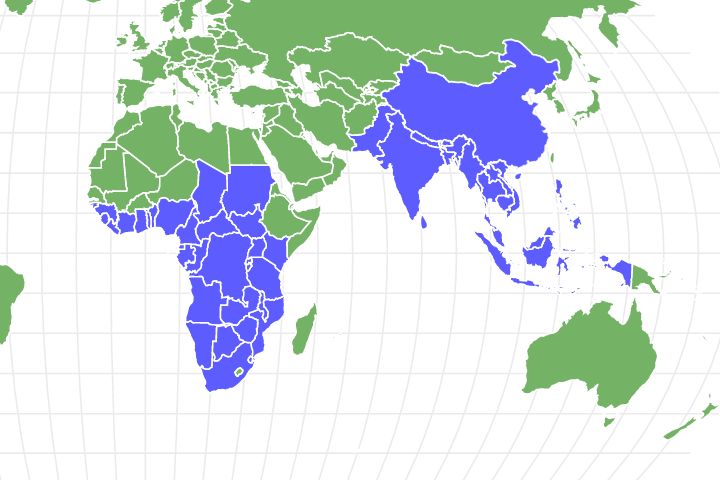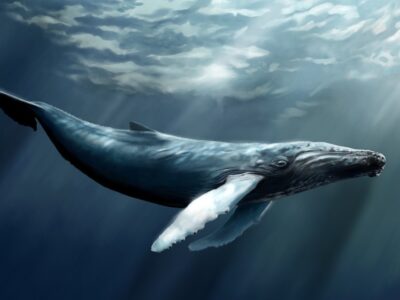Pangolin
Bad eyesight, but great sense of smell
Advertisement
Pangolin Scientific Classification
- Kingdom
- Animalia
Read our Complete Guide to Classification of Animals.
Pangolin Conservation Status
Pangolin Facts
- Prey
- Ants, Termites, Larvae
- Name Of Young
- Pup
- Group Behavior
- Solitary
- Fun Fact
- Bad eyesight, but great sense of smell
- Estimated Population Size
- unknown
- Biggest Threat
- poaching
- Most Distinctive Feature
- Scaled body
- Other Name(s)
- scaly anteater
- Gestation Period
- 70-140 days
- Litter Size
- 1-3
- Habitat
- Various
- Predators
- Humans, Lions, Hyena, Snakes
- Diet
- Carnivore
- Type
- Mammal
- Common Name
- Pangolin
- Number Of Species
- 8
- Location
- Asia, Africa
- Group
- Solitary
Pangolin Physical Characteristics
- Color
- Brown
- Grey
- Skin Type
- Scales
- Top Speed
- 3 mph
- Lifespan
- 240 months
- Weight
- 1.6kg - 33kg (3.5lbs - 73lbs)
- Length
- 30.5cm - 99cm (1ft - 3ft)
- Age of Sexual Maturity
- 2 years
- Age of Weaning
- 3 months
View all of the Pangolin images!
“The Pangolin is the most trafficked mammal on the planet.”

The pangolin isn’t an ordinary animal by any means. They have interesting scales and a characteristic reaction of rolling over when threatened, leaving a distinct impression on those who encounter them. Their unique coat has also made them a prime target for poaching and trafficking, which has significantly diminished native populations around the world. Despite similarities to anteaters in diet and appearance, these small mammals are actually quite distinct and are classified into their own taxonomic order.
Incredible Pangolin Facts!
- Pangolin scales are composed of clusters of hair made from keratin.
- Pangolins look and behave similarly to anteaters, but aren’t closely related to them genetically.
- Pangolins are animals with scent glands that can spray odors as a secondary defensive mechanism.
- Pangolins are one of the most trafficked animals in the entire world.
You can check more incredible facts about pangolins.
Scientific Name
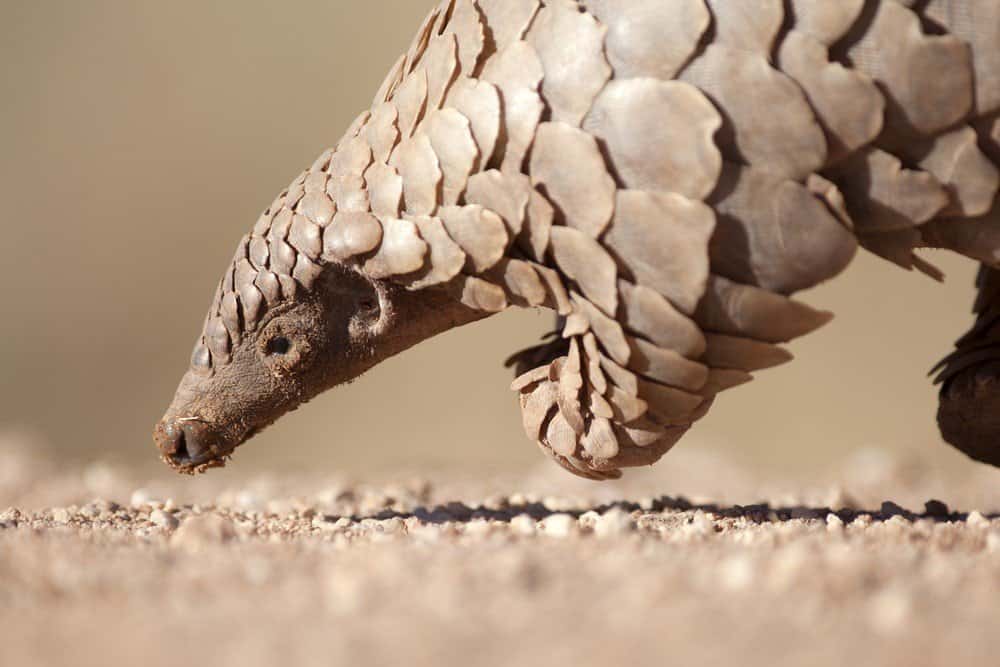
Pangolins may look and act much like anteaters and armadillos, but these unique creatures aren’t closely related to either.
©2630ben/Shutterstock.com
Pangolins are also known as scaly anteaters, although they are distinct from actual anteaters in both taxonomy and genetics aside from their shared origins in the Mammalia class. All 8 species are members of the Manidae family of the order Pholidota, which is named after the old Greek word for “horned scale.” The 8 species are spread among three genera: Manis, Phataginus, and Smutsia.
Appearance

Pangolins are the only mammals with scales.
©Positive Snapshot/Shutterstock.com
Pangolins aren’t the most elegant or graceful animals, but what they lack in aesthetics they make up for with specialized functionality. Their bodies can range from 1 to 3 feet in length with an adult’s tail length extending between 10 and 30 inches. They have relatively small, pointed heads that are adapted for infiltrating insect burrows and nests.
These mammals have several unique adaptations and features, including a complete lack of teeth in their mouth. Instead, they have a long and mobile tongue that is perfectly designed for preying on insects. Their stubby legs are also equipped with sets of sharp claws that help them latch on to trees and rip into nests as they search for prey. Their prehensile tail also functions as a crucial support for their body as they use their front legs as multi-purpose tools.
The Pangolin’s Unique Scales
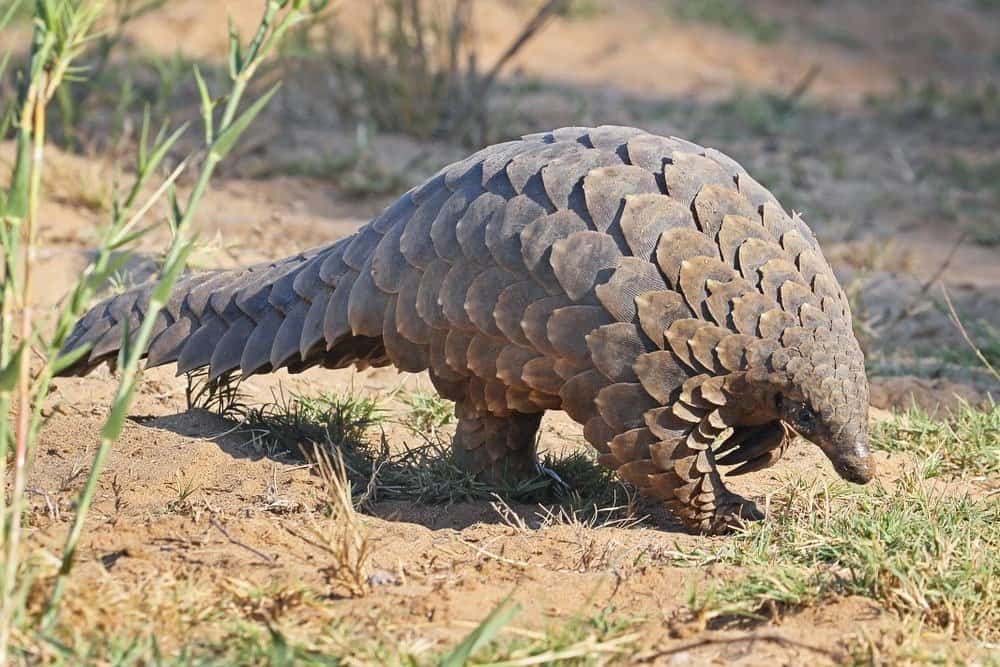
Pangolins are the most trafficked animal in the world for the perceived medicinal value of their scales.
©Eugene Troskie/Shutterstock.com
The pangolin’s scales are their most noteworthy feature and one of the reasons they are highly trafficked. These formations are actually formed by clumps of hair made of keratin, which is the same substance found in human fingernails. These clumps are soft on newborns, but quickly begin to harden into strong scales as they mature. They form durable armor that acts as a defense mechanism when the animal curls into a tight ball when faced with an imminent threat.
Behavior
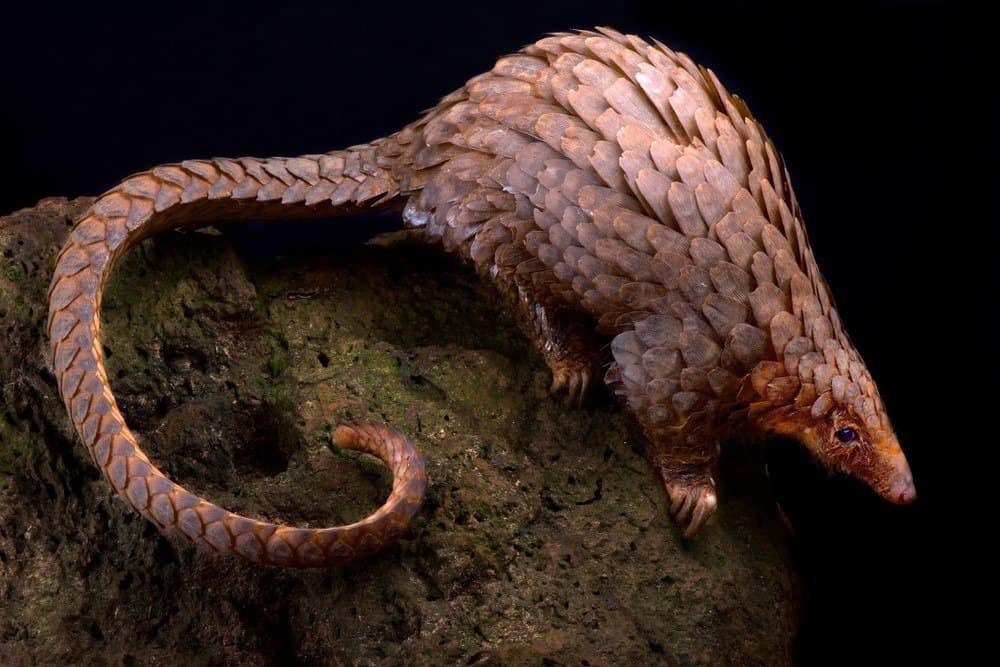
Some types of Pangolins use their long tails to maneuver about the branches of trees.
©reptiles4all/Shutterstock.com
Pangolins are generally shy and solitary, preferring to live alone or in pairs. They are primarily nocturnal, with the exception of one species, and may seek food in trees or along the ground. Their body and armored scales allow them to employ a defensive ball posture, much like an armadillo, when facing predators. They also have scent-secreting glands that allow them to propel a noxious spray as a deterrent against threats.
Evolution
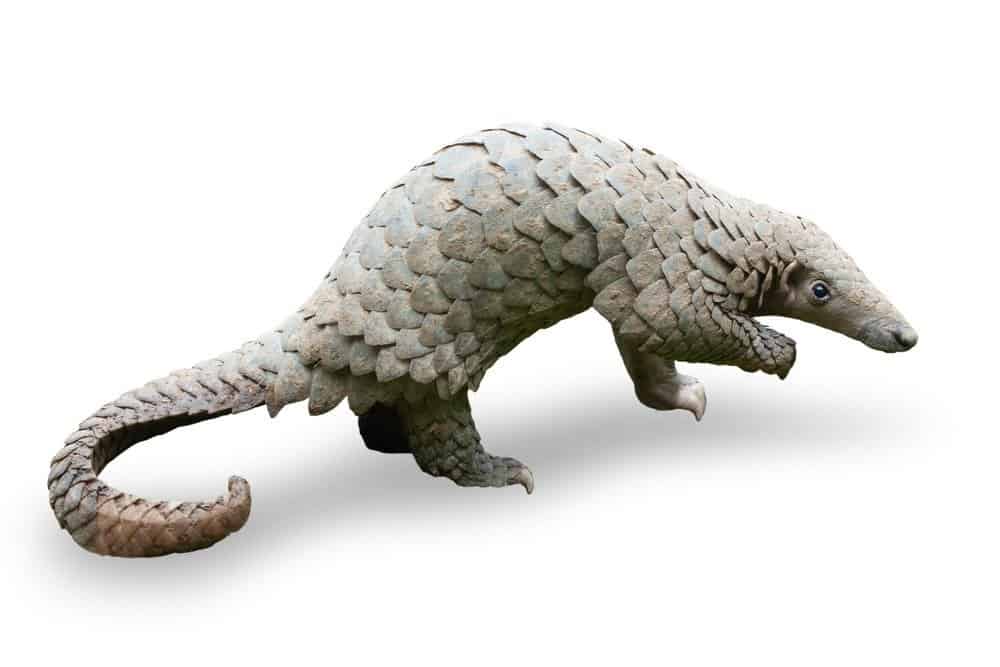
Pangolin’s evolutionary history is a bit of a mystery to scientists.
©Binturong-tonoscarpe/Shutterstock.com
Despite being one of the most genetically unique animals on earth, the pangolin is also one of the least understood from an evolutionary point of view. They are the only placental mammals without a complete genome map, so scientists studying their DNA must do some guesswork to fill in the gaps in their family tree. The oldest modern pangolin fossils found are around 2.3 million years old, though fossils of some close ancestors of modern species which are now extinct have been dated back to 50 million years old. Ancient and present-day pangolins appear to be strikingly similar in genetic makeup.
Traits the pangolin has evolved include their distinct protective scales, as well as an acute sense of smell, complex musculature, long, probing tongues, and a harsh odor they can emit to ward off predators.
Habitat
Pangolins are found in diverse habitats in both Asia and Africa. Manis pentadactyla is found throughout China, M. javanica is native to various locales in southeast Asia and M. crassicaudata is native to India. The remaining 5 species are found in central and southern Africa, with a range spanning over half of the continent.
Some species are arboreal, so they spend most of their time sleeping, hunting, and living in trees. Their sharp claws and large, flexible tail allow them to keep a grip on vertical surfaces while using their front claws to break into insect nests. Other species are primarily terrestrial, which means they stick to the ground and typically dwell in burrows. All species are able to navigate the water with some skill, although they are not known to frequent aquatic environments.
Diet
Much like anteaters, pangolins are exclusive insectivores that typically seek prey that dwells in hives or large nests. What they lack in acuity of vision, they make up for with an extremely strong sense of smell. Their keen nostrils help them seek out prey and pinpoint their location beneath soil or under tree bark.
What do Pangolins Eat?
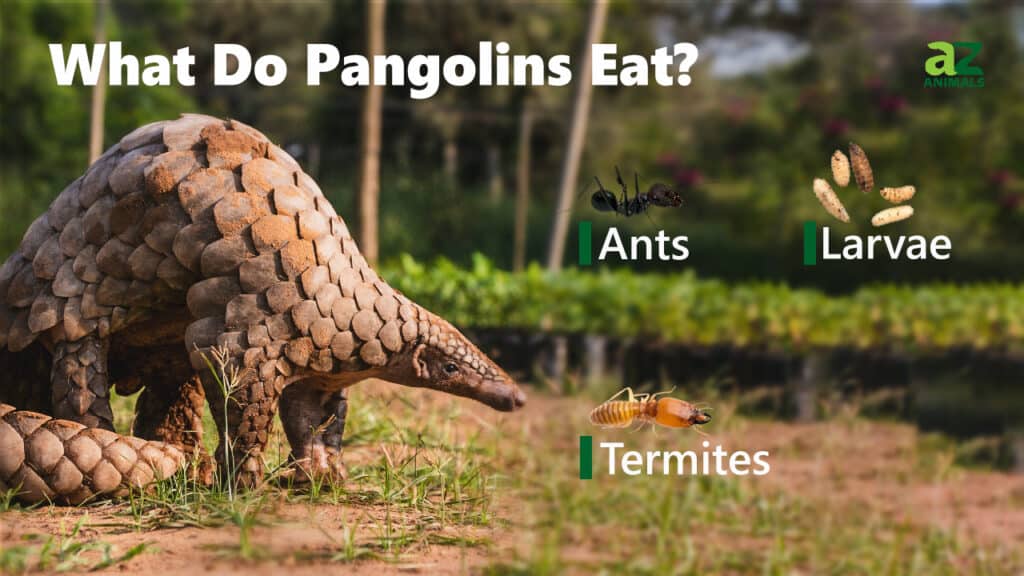
Ants and termites are prime targets due to their centralized nest structure and plentiful populations. Larvae of various insects also serve as a potential source of food, particularly for arboreal pangolin species. Their long, flexible tongue and sticky saliva are perfect for capturing small insects in their nests or along rugged surfaces.
Predators and Threats
Humans are by far the most significant threat to pangolin populations across the world. The animals have long been hunted as a source of food, but their scales are also highly prized in some cultures as an ingredient in traditional medicine. As the most trafficked mammal in the world, all pangolin species face some risk of extinction. Current classifications among the 8 species range from vulnerable to critically endangered and there are strict controls on the international trade of both meat and scales.
While human poaching and hunting are the primary concerns when it comes to population management, there are natural predators throughout the pangolin’s native range as well. Any large local predator can be a potential threat, including hyenas, lions, and pythons.
Pangolin and COVID

Some scientists believe a coronavirus present in some pangolins could have caused the COVID-19 outbreak due to the consumption of the endangered animals.
©Fit Ztudio/Shutterstock.com
In 2020, COVID researchers discovered that pangolins were host to a coronavirus that was extremely similar to the one responsible for the COVID-19 pandemic. While this did not establish a definitive link or suggest the animal as a possible carrier, it did raise concerns about the animal functioning as a vector for coronavirus infection. This makes them the second animal, after bats, identified as a possible source or carrier for the coronavirus. This revelation also caused conservationists some concern over the risk of people targeting pangolins for extermination to reduce the perceived risk of COVID.
Reproduction and Life Cycle
Pangolin pairs typically mate only once a year, with regional mating seasons usually occurring during the summer or fall seasons. Males leave scent markers to attract potential mates to their territory. In competitive situations, adversarial males use their heavy tails as weapons to achieve dominance and earn the right to reproduce with females.
Mothers usually only give birth to one pup at a time, but some species in Asia can have two or three at once. The typical gestation period varies depending on the species, ranging between 70 and 140 days. The first few weeks of life are spent tucked away in a burrow or nest. After the pup has matured a bit and its soft scales have begun to harden, it rides on its mother’s tail or back to accompany her while she hunts.
The weaning process typically begins after a few months, but pangolin pups may stay with their mother for up to two years. Mothers eventually abandon their young when they’ve reached an appropriate age to fend for themselves. Life expectancy in the wild is uncertain, but animals have been known to live for up to 20 years in captivity.
Population
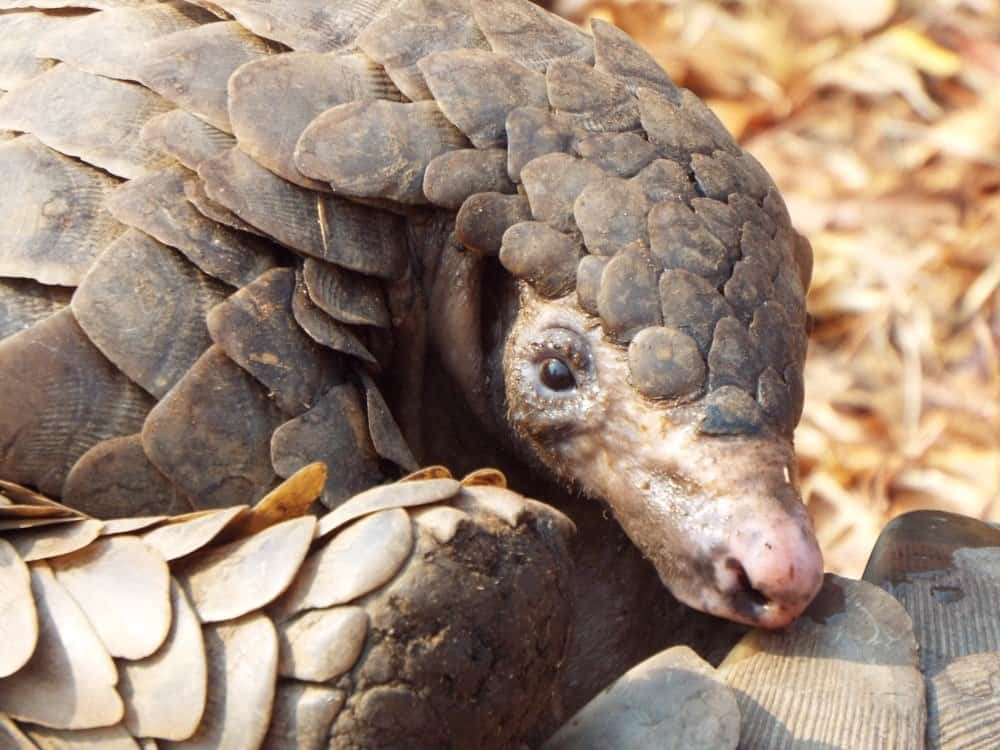
Pangolin populations are perpetually threatened by poachers.
©Patrick Fonseca/Shutterstock.com
While conservationists don’t have a clear idea of total pangolin population numbers in Asia and Africa, there is plenty of reason to believe that they are in sharp decline. Hundreds of thousands of the animals are killed for their meat and scales every year, which prompted a massive international ban on all commercial trade in 2016.
Types of Pangolins
There are currently eight different species of pangolins alive today, four of them belong to the genus Manis, while the other four species fall under either genera Phataginus or Smutsia. You can read all about the eight kinds of pangolin below!
| Name | Description |
| Black-Bellied Pangolin | (Phataginus tetradactyla) This species is found in Central and West Africa and is distinguishable by its extremely long tail that they use to climb trees. |
| Temminck’s Pangolin | (Smutsia temminckii) Temmick’s Pangolin is the only species native to Southern Africa, and the only African pangolin not to live in trees, preferring instead to utilize vacant burrows left by local aardvark for shelter. |
| White-Bellied Pangolin | (Phataginus tricuspis) These African pangolins are arboreal, meaning they live in trees like their black-bellied relatives. They are the most populous species of pangolin on the continent. |
| Giant Pangolin | (Smutsia gigantea) This is the largest living species of pangolin, weighing up to 77 lbs. They are found in West and Central Africa. |
| Sunda Pangolin | (Manis javanica) Sunda Pangolins have the widest range of any Asian pangolin, with populations spanning from Thailand to Malaysia. |
| Philippine Pangolin | (Manis culionensis) Found only in four islands of the Phillippines, these pangolins have more scales than any other species. |
| Indian Pangolin | (Manis crassicaudata) This kind of pangolin is fossorial, meaning they spend most of their time on the ground. They’re known to wander into local villages on occasion. |
| Chinese Pangolin | (Manis pentadactyla) These pangolins burrow underground to stay warm in the winter, and their populations overlap with those of local termite species which supply them with food. |
Pangolin FAQs (Frequently Asked Questions)
What is a pangolin?
Pangolins are a group of medium-sized mammal species that are native to various regions of Africa and Asia. They are nocturnal insectivores that have physical characteristics similar to an anteater or armadillo, although they aren’t directly related to either animal. All 8 pangolin species are heavily threatened by poaching and trafficking despite international restrictions on the trade of meat, scales, and live animals.
What is a pangolin related to?
Due to visible similarities with sloths, anteaters, and armadillos, pangolins were once classified in a related taxonomy. However, genetic evidence has caused scientists to place them in a distinct clade within the Mammalia class that has few direct relatives. Pangolin species currently found in the wild are thought to have various extinct relatives based on available fossil evidence.
Pangolin vs. Armadillo
While they aren’t related in taxonomy, pangolins and armadillos do share similar body structure, size, and shape. They are also both mammals that rely on hard skin and readily assume a ball-like posture as a defense mechanism. However, armadillos rely on tough layers of skin and pangolins have scales formed by hair clumps composed of keratin.
What are pangolin scales used for?
The pangolin’s unique keratin enhanced fur scales are highly desired in traditional medicine in Asian and African cultures. They also have historical ornamental uses in fashion and hand-crafted objects.
What does a pangolin eat?
Pangolins are insectivores, which means they survive exclusively by hunting bugs. Their pointed nose and long, sticky tongue are adapted for fishing out ants, termites, larvae, and other insect species from their nests. They have a keen sense of smell that helps them locate prey as well as claws that are perfect for digging and ripping apart wood.
Where does pangolin live?
Depending on species, pangolins can be either arboreal or terrestrial. Arboreal species spend almost all of their time on the trunks and branches of trees, seeking shelter and food there. Their terrestrial counterparts typically live in subterranean burrows and stick close to the ground, although all species are able to navigate across water when necessary.
What Kingdom do Pangolins belong to?
Pangolins belong to the Kingdom Animalia.
What type of covering do Pangolins have?
Pangolins are covered in Scales.
What are some predators of Pangolins?
Predators of Pangolins include humans, lions, hyenas, and snakes.
What is the lifespan of a Pangolin?
Pangolins can live for 240 months.
How many species of Pangolin are there?
There are 8 species of Pangolin.
What is a baby Pangolin called?
A baby Pangolin is called a pup.
What is the biggest threat to the Pangolin?
The biggest threat to Pangolins is poaching.
What is another name for the Pangolin?
The Pangolin is also called the scaly anteater.
How many Pangolins are left in the world?
The population size of the Pangolin is unknown.
How many babies do Pangolins have?
The average number of babies a Pangolin has is 1 to 3.
What is an interesting fact about Pangolins?
Pangolins have bad eyesight, but a great sense of smell.
How fast is a Pangolin?
A Pangolin can travel at speeds of up to 3 miles per hour.
How does a Pangolin compare to an Armadillo?
Pangolins and armadillos both have protective surfaces that form a kind of “armor” against predators. Yet, when comparing pangolin vs. armadillo, there are many key differences. For one, their armor is very different in shape. Second, pangolins evolved to not have teeth while armadillos have a mouth full. Finally, the two animals come from different families with armadillos more closely related to sloths and anteaters.
What are the key differences between a pangolin and an anteater?
The key differences between a pangolin and an anteater are size, distribution, and armor.
Thank you for reading! Have some feedback for us? Contact the AZ Animals editorial team.
Sources
- David Burnie, Dorling Kindersley (2011) (1970) Animal, The Definitive Visual Guide To The World's Wildlife
- Tom Jackson, Lorenz Books (2007) (1970) The World Encyclopedia Of Animals
- David Burnie, Kingfisher (2011) (1970) The Kingfisher Animal Encyclopedia
- Richard Mackay, University of California Press (2009) (1970) The Atlas Of Endangered Species
- David Burnie, Dorling Kindersley (2008) (1970) Illustrated Encyclopedia Of Animal
- Dorling Kindersley (2006) (1970) Dorling Kindersley Encyclopedia Of Animals
- David W. Macdonald, Oxford University Press (2010) (1970) The Encyclopedia Of Mammals

